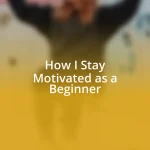Key takeaways:
- A guitar solo showcases a musician’s technical skill and emotional depth, transforming a melody into a powerful experience.
- Analyzing solos enhances understanding, technical growth, and emotional connection, leading to a deeper appreciation of music.
- Creating original solos involves trusting instincts, storytelling, and capturing personal experiences, resulting in meaningful performances.

What is a guitar solo
A guitar solo is essentially a moment of expressive freedom within a song, allowing musicians to showcase their technical skill and emotional depth. I remember the first time I really listened to Eric Clapton’s “Layla” and felt my heart race at the soaring, passionate notes. Isn’t it fascinating how a few bends and slides can convey feelings that words sometimes can’t?
In a musical piece, a guitar solo often serves as a pivotal point, turning a simple melody into an unforgettable experience. I often find myself lost in the solos of classic rock songs, where each note seems to tell a story. Have you ever felt that rush when a solo kicks in, pulling you into its world? That connection between the solo and the listener is what makes it so powerful.
Beyond just technical prowess, the beauty of a guitar solo lies in its ability to evoke emotions—joy, sadness, nostalgia, or even exhilaration. I once played a solo at a local gig, and the feeling of sharing that moment with the audience was incredible. What makes a great solo resonate with you? It’s often the blend of creativity and personal expression that creates a lasting impression.

Importance of analyzing solos
Understanding the importance of analyzing guitar solos opens up a whole new world for musicians and listeners alike. When I first sat down to break down a solo note by note, I was amazed at the layers within the music. Each note played carries a specific purpose, shaping the song’s overall emotion and intensity. This kind of analysis not only strengthens my playing but deepens my appreciation for the artistry involved in crafting each solo.
Another aspect I’ve found invaluable is the learning opportunity that comes with dissecting solos. For instance, studying Eddie Van Halen’s “Eruption” taught me pivotal techniques like tapping and legato, which I could incorporate into my own repertoire. I remember practicing those techniques over and over, trying to capture that explosive energy. By analyzing solos, we can uncover the nuances that make each performance unique and translate them into our style.
Finally, analyzing solos fosters a greater connection to the music. When I first really listened to the intricate details in a Joe Satriani piece, it was as if I had unlocked a hidden door to his emotions. It made me feel more connected to the artist’s journey, transforming mere notes into a dialogue between musicians and their audience. Have you ever found a piece that just spoke to you? Analyzing it can help you understand why it resonates deeply.
| Benefits of Analyzing Solos | Examples from My Experience |
|---|---|
| Enhanced Understanding | Discovering layer and purpose in each note |
| Technical Growth | Learning techniques like tapping from iconic solos |
| Emotional Connection | Feeling resonation with artists like Joe Satriani |

Techniques used in guitar solos
When it comes to guitar solos, various techniques can create distinct sounds and emotional responses. I often find myself captivated by the power of techniques like bends, slides, and vibrato. These techniques can transform a simple lick into a gripping moment that lingers in your mind. For instance, I vividly remember my excitement during a jam session when I nailed a perfect bend—it was like the guitar was speaking directly to my heart.
- Bends: Altering pitch to express emotion.
- Slides: Connecting notes smoothly for a fluid sound.
- Vibrato: Adding richness and depth to sustained notes.
Advanced techniques can bring an extra layer of complexity and flair that makes solos stand out. Take alternate picking and sweep picking, for example. The first time I attempted sweep picking, I felt like I was unlocking a secret door to faster playing. That initial rush of speed and fluency is something that many guitarists seek. Learning these techniques diversifies your playing and gives you tools to craft solos that resonate with listeners.
- Alternate Picking: Quick, precise picking for enhanced speed.
- Sweep Picking: A technique for playing arpeggios smoothly without pausing.
- Tapping: Hammering on and pulling off notes for a fleet-footed sound.
Each of these methods offers a different flavor, and the more I explore them, the more I realize how personal interpretation can vary with every guitarist. Just the other day, while experimenting with tapping on a new piece, I discovered a sound that felt like it was uniquely mine—such moments are what make the journey thrilling. What techniques inspire you?

Common mistakes in guitar solos
One of the most common mistakes I’ve seen in guitar solos is overplaying. It’s easy to get caught up in the excitement and throw in every flashy technique at your disposal. But trust me, sometimes less is more. I remember the first time I recorded a solo where I crammed in bends, slides, and even a few taps—I thought I was killing it. When I listened back, it just sounded cluttered and frantic. Finding that balance between intricacy and simplicity can be key to making a memorable solo.
Another mistake I often observe is neglecting phrasing. Each note and phrase should have a purpose and emotion behind it. I recall a time during my practice sessions when I focused solely on speed. I could play fast, but it didn’t say anything to me or the audience. When I started emphasizing the spaces between my notes, it transformed my playing. How do you feel when a solo breathes? It allows for those moments of tension and release, making the music come alive.
Lastly, failing to connect with the underlying song can be detrimental. Guitar solos should complement the music rather than overshadow it. I had an enlightening moment when I played along with a friend’s band—my solos didn’t resonate like I thought they would. It became clear that if I didn’t align with the band’s energy and vibe, I was just adding noise. This taught me to really listen and adapt, creating solos that blend seamlessly into the song’s fabric. Have you ever found your playing at odds with the music? That awareness can shift your approach entirely.

Learning from famous guitarists
Learning from legendary guitarists is like opening a treasure chest of techniques and styles. I remember the first time I dove into Eric Clapton’s solos; his ability to convey emotion with each note left a lasting impression. It’s fascinating how some guitarists make you feel their pain or joy through their playing. Have you ever felt that connection with a solo? I certainly have, and it’s pushed me to explore my own emotional expression on the guitar.
Then there’s the brilliance of Jimi Hendrix, who turned every performance into a wild adventure. I still recall trying to emulate his iconic wah-wah pedal usage. Initially, it felt daunting, but the moment I got it right, something clicked; it was like finding a new gear in my playing. How do you think experimenting with different techniques can unlock creativity? For me, it’s a game-changer, allowing me to discover sounds I never thought I could achieve.
Analyzing solos from guitar greats like David Gilmour taught me the art of building tension. His use of long, sustained notes followed by explosive bursts shaped my understanding of dynamics. There was a moment during a late-night jam when I decided to focus on creating space in my playing, inspired by his approach. I could feel the audience leaning in, and it struck me: every single note can hold power when placed thoughtfully in a solo. Isn’t it amazing how much we can learn from those who’ve walked the path before us?

Applying lessons to your playing
Taking the lessons I’ve gleaned from analyzing guitar solos, I’ve found that focusing on clarity in my playing has made a significant difference. Just last week, during a jam session, I decided to strip away unnecessary runs and instead emphasized a few melodic ideas. The moment I did that, I noticed my bandmates nodding along, fully engaged. It was a reminder that sometimes, playing less actually allows your ideas to shine more brightly.
Integrating phrasing into my solos has also been transformative. I vividly remember a moment in my early performances where I played too fast and lost the emotional connection with the audience. Now, I consciously map out my phrases, almost like writing a story with my guitar. Have you ever tried this? It’s incredible how much more responsive listeners are when you weave in pauses and let the notes breathe.
Furthermore, I’ve started to pay closer attention to the structure of the songs I’m playing over. I had a breakthrough when I realized that each section provides a distinct atmosphere. Aligning my solo’s intensity with the dynamics of the verses and choruses is something I’ve recently focused on. This shift has made my playing feel more cohesive and intentional. Isn’t it rewarding when you can feel the music swell around you, and your guitar complements that energy? It’s one of those exhilarating moments that keeps me motivated to keep learning and growing as a guitarist.

Creating your own guitar solos
Creating your own guitar solos is an exhilarating journey of self-discovery. I remember the first time I put my feelings into notes; it was like finding a voice I never knew I had. Do you remember that thrill? Each time I pick up my guitar, I try to channel a different part of my life or mood, and that personal connection transforms the notes into something meaningful.
One of the key lessons I learned is to trust my instincts. The first time I improvisationally played a solo in front of friends, I was a bundle of nerves. But as I let the music flow, I found myself becoming more comfortable with the process. It’s almost magical how shifting from a rehearsed piece to spontaneous creativity can feel so freeing. Honestly, have you ever had a moment where you felt completely lost in the music? Those moments are both exhilarating and terrifying, but they often lead to the most memorable solos.
In crafting my solos, I’ve discovered the power of storytelling. Each note in my solos can serve a purpose, creating a beginning, middle, and end. I once wrote a solo that mirrored my experience at a recent concert; the excitement built up, then broke down, just like waves of emotion cascading through a melody. Does that resonate with you? Capturing the essence of my experiences through music has not only improved my improvisation but has also deepened my overall connection to the guitar.















